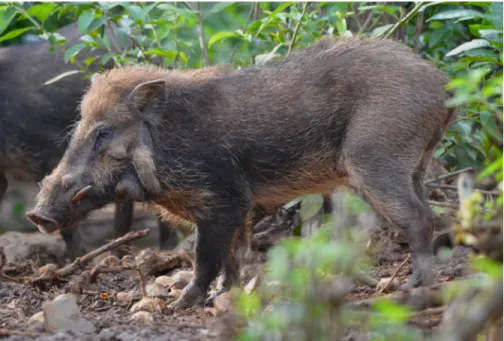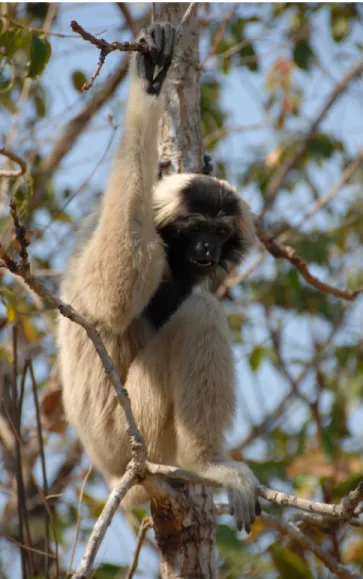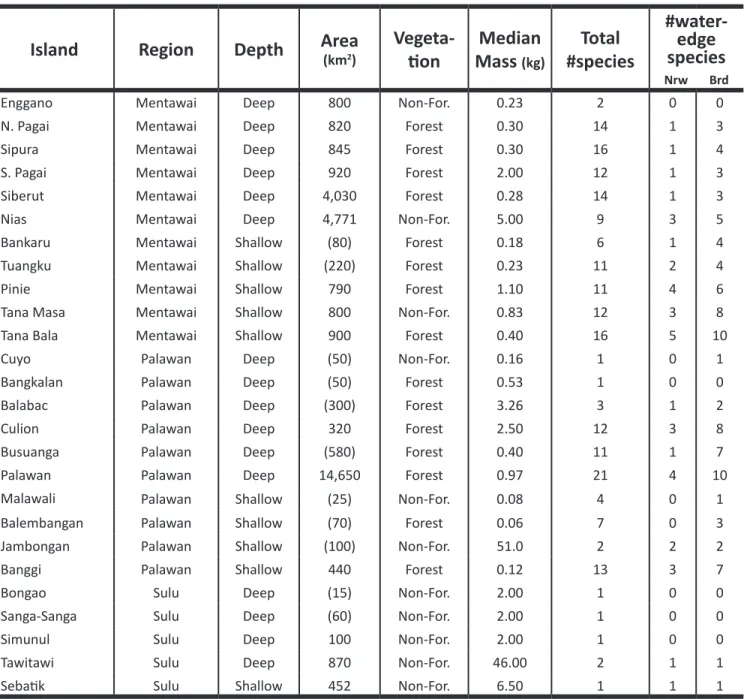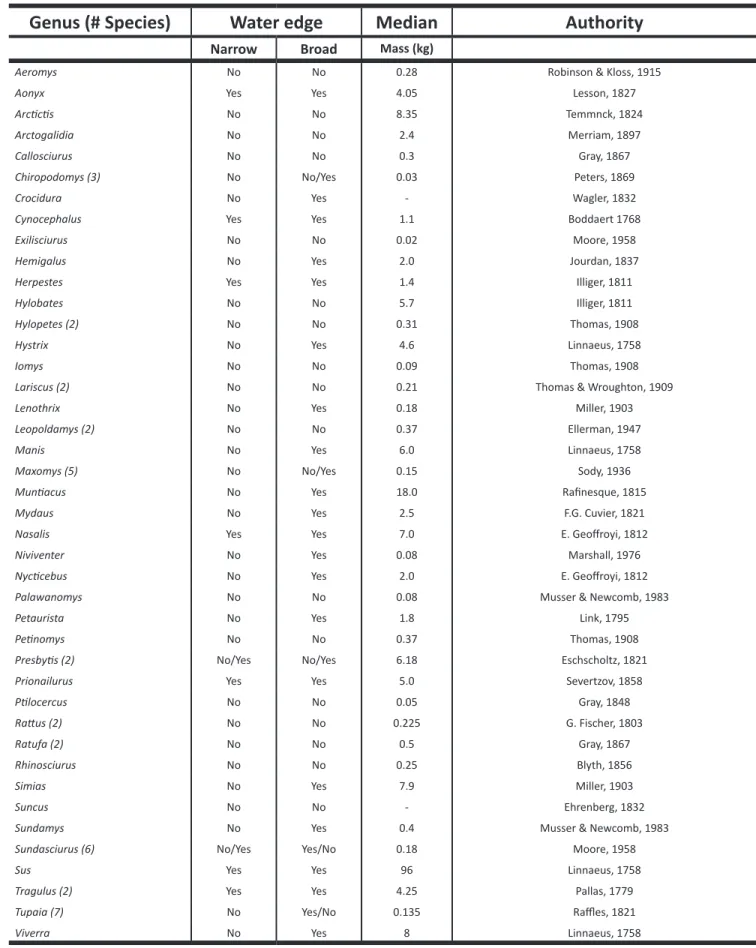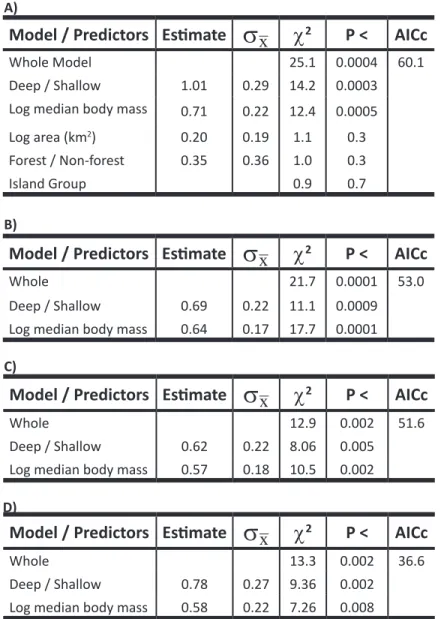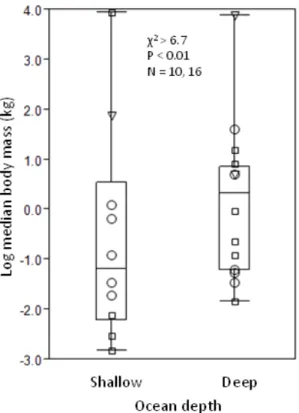The Department of Biology at the University of Andalas is committed to educating Indonesian biologists in the study and conservation of Indonesia's biodiversity and natural history. Southeast Asia has faced a critical extinction crisis in recent decades and biodiversity conservation needs a boost in metapopulation management across the region.
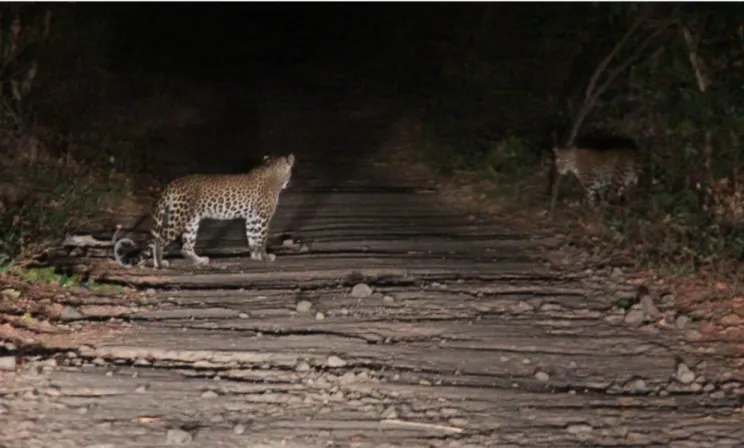
Preventing the extinction of the Sumatran rhinoceros
In the absence of agreement to share rhinos and gametes between nations and facilities, the current scope in Malaysia is extremely limited. Seven years later, between 17.-29. September 2010, seven Malaysian tapirs died of mucoid E.coli at the same facility, and only one of the tapirs showed trypanosomes in the blood.
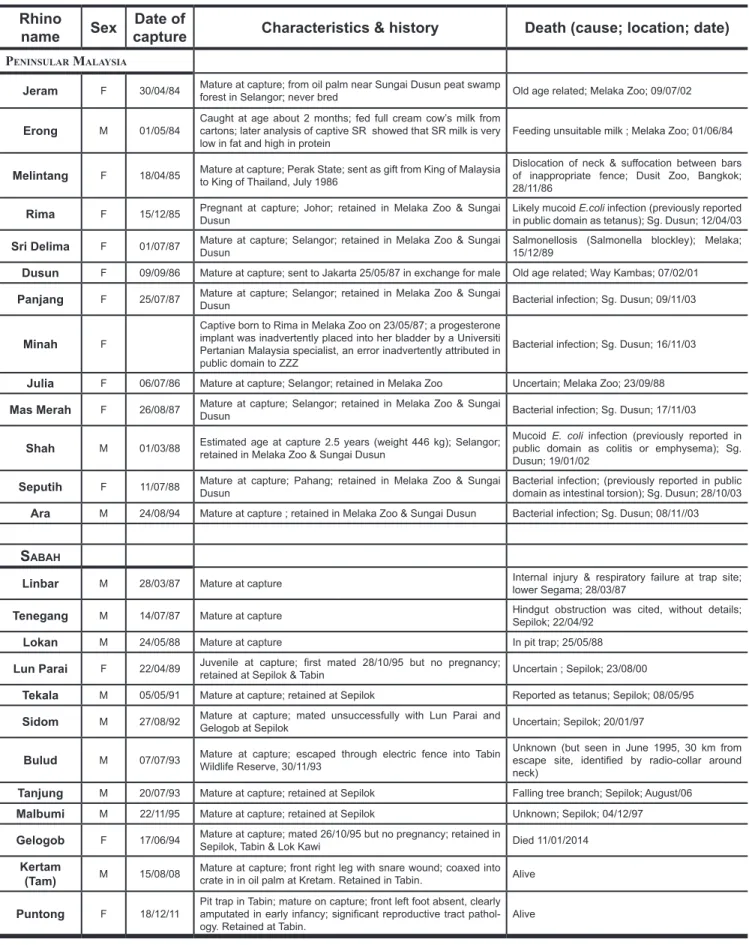
Without weeding, natural woody growth would provide part of the rhinos' food needs. Preventing the extinction of the SR rhino cannot necessarily be achieved in the longer term by protecting wild rhinos.
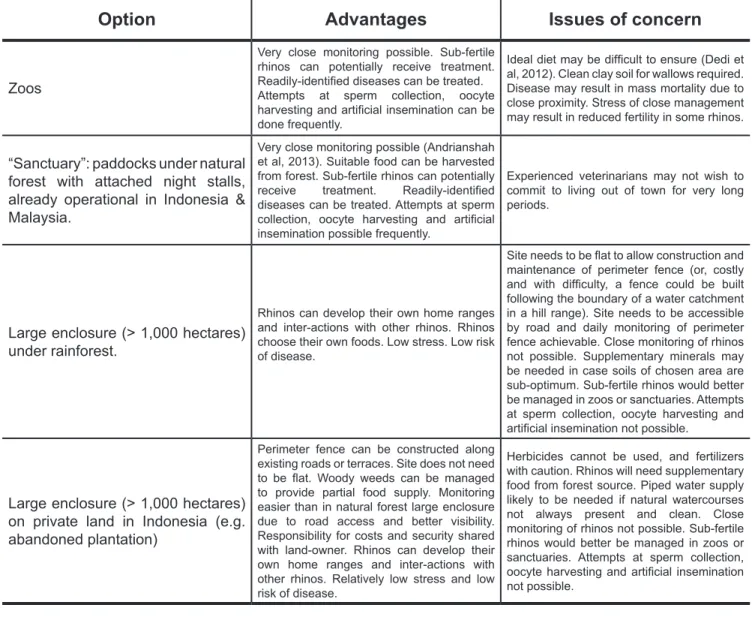
Melting and wallowing use of the Sumatran rhinoceros (Dicerorhinus sumatrensis) in a natural enclosure in Sungai Dusun Wildlife Reserve, Selangor, Malaysia. The distribution and status of the Asian two-horned rhinoceros (Dicerorhinus sumatrensis harrissoni) in Sabah, Malaysia. Junaidi Payne's interest began with a survey of the SR population in the Endau Rompin Forest of Peninsular Malaysia in 1977, led by the late Nico van Strien.
In 2010, Zainal left government service and joined Junaida Payne and Abdul Hamid Ahamd as a veterinarian and field manager for the Borneo Rhino Alliance (BORA), a non-governmental organization dedicated to preventing the extinction of the SR in Borneo (www. borneorhinoalliance.org). In Abstracts of the International Symposium on Elephant and Rhinoceros Research (ed. H.M. Schwammer, T.J. Foose, M. Fouraker and D. Olson), p.322. Displacement of Asian elephants Elephas maximus, Sumatran rhinoceroses Dicerorhinus sumatrensis and Malayan tapirs Tapirus indicus in Peninsular Malaysia.
A preliminary test of a prediction from the rafting hypothesis for the presence of non-flying mammals on islands
Although some cases of rafting have been confirmed, for example a correlation of the direction of gene flow among Caribbean anole lizards with the direction of ocean currents in the region (Calsbeek and Smith, 2003), most suggestions of rafting are hypotheses, especially for mammals earthly. The absence of non-domestic land mammals in the central Pacific islands may be evidence of the impossibility of rafting as a means of dispersal across water, at least over long distances (Gillespie et al., 2012). However, Houle calculated that ocean currents could have transported the founders of New World primates across the then 1400 km wide Atlantic in a period of only two weeks (Houle, 1998).
Abegg and Thierry (2002) developed one of the few quantitative predictions to test the rafting hypothesis. Abegg and Thierry hypothesized that the crab-eating macaque's wider distribution resulted from its greater likelihood of going to sea on a raft of vegetation. Here we test the Abegg-Thierry prediction using available information on the distribution of the non-flying mammal community of the Sunda region of insular Southeast Asia (Meijaard, 2003).
In common with several biogeographical patterns (Crisp et al., 2011), the hypothesis of rafting by mammals often remains untested against alternative hypotheses, and few are explicitly tested for the distribution of terrestrial mammals. Therefore, for the analysis we chose to distinguish between "deep water" and "shallow water islands". We used Voris' (2000) calculations of Southeast Asian land extent at various ocean depths to separate deep water from shallow water islands.
Deep water islands are separated from a main continent by ≥ 120m of sea, and shallow water islands by < 120m. Using this definition, deep-water islands should still receive more rafting immigrants than the shallow-water islands, even if sea levels fell more than 120m, because the deep-water islands will be separated from sources for longer than the shallow water. water islands. With this assumption, we predicted that deep-water islands should have a predominance of riparian species compared to shallow-water islands.
Island Region Depth Area
Vegeta-
Mass (kg) Total
However, the number of species was the unit of analysis because most genera were represented by only one species on each island (slope of 1.1 for species per genera), and analysis by genera would have produced a very similar result. We took body mass into account because it can affect both the probability of rafting as well as post-rafting survival. Heaney (1986) noted that most of the species on the small Southeast Asian islands were rodents.
Perhaps a relatively greater number of small-bodied individuals can fit on a raft, thereby increasing the likelihood of successful settlement upon arrival (Kappeler, 2000). Additionally, smaller animals require smaller rafts, effectively increasing the number of available rafts that can transport small animals. On small islands, small-bodied animals are more likely to reach sustainable populations than large ones (Harcourt 1999).
Genus (# Species) Water edge Median Authority
In the narrow classification, we included species with aquatic habitats described as "waterfront", "sometimes by rivers", and "mangrove". If the literature did not mention a "preference for water", we classified the species as "non-aquatic". In the broad definition, we classified all described species that have some preference and association with water as "water's edge", including species with broad habitat tolerance.
For a riparian species to survive on an island, we hypothesized that the island must also have suitable habitat available --- such as riparian habitat. We used island area as a quantitative measure of potential riparian habitat, assuming that larger islands would typically have more coastline and more rivers, and therefore would have a greater area of riparian and riparian forest. The combined influence of all hypothesized variables was studied using the binomial logit generalized linear model, with the number of species at the water's edge and the total number of species as response variables, as well as island category (deep water, shallow water), island area, mean body mass of species on the island, presence-absence forest species on the island and the region of the island as possible determinants.
All statistical tests were performed with JMP 9.0 (SAS Institute Inc., 2011); probabilities are two-sided; .. probabilities of 0.1 or greater are represented as 'ns'. 17, Wilcoxon/Kruskal-Wallis Rank Sums), sampled species on deep-water islands were on average larger than those on shallow-water islands (Fig. 3). Water-edge taxa (larger than non-water-edge species) were found on shallow-water islands, while large-bodied taxa (on average with a water-edge) were found on deep-water islands. Here, numbers of the two species are more similar than in the narrow definition, and island type (deep vs. shallow water) and body mass were significant correlates (Table 4A).
Contrary to our expectations, edge species were more common on shallow than on deep-water islands, although edge-of-water genera were larger than non-edge genera (i.e., sea depth and body mass remained significant predictors of presence on deep-sea islands in compared to shallow islands (Table 4C).Island type (deep vs. shallow water) and body mass remained significant variables (Table 4D): water-edge species were more common relative to total species on shallow than on deep-water islands, and larger species were most common on deep-sea islands.
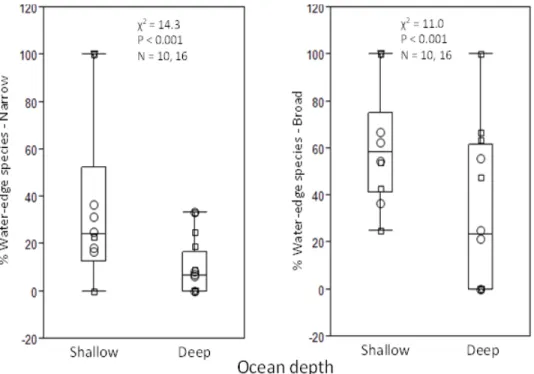
Wild animal keeping could be a much older practice, considering that it occurs in traditionally living societies across much of the world (Fuentes and Wolfe, 2002). Such accidental transport could easily explain how the <50g skink, Lipinia noctua, spread so quickly over much of the Pacific (Austin, 1999). Fooden (1995) suggested that the various morphological differences between island forms of the long-tailed macaque were significant enough to rule out the possibility of human transport.
Most other mammals in the region are smaller-bodied than primates and have shorter life cycles than primates (Harvey et al., 1987; Read and Harvey, 1989). All older origins are irrelevant to the rafting theory because sea levels at the origin of the Mentawai 2.5mya were lower than in the Pleistocene (Ziegler et al., 2007). Vegetation history of the savanna corridor between the Guinean and Congolese rainforests during the past 150,000 years.
Camera trapping as a conservation tool in a mixed-use landscape in East Kalimantan
In 2007, a conservation department (REA KON) was activated to address important issues within the PT area. In general, more mammal species in Hulu Belayan were photographed along the north/east bank of the Belayan River compared to those seen on the south/. Diet and habitat selection of the leopard cat (Prionailurus bengalensis borneoensis) in an agricultural landscape in Sabah, Malaysian Borneo.
McKenzie (1995) Environmental Impact Assessment of the Oil Palm Estate of PT REA Kaltim Plantations, East Kalimantan, Indonesia. The ability to build holes for nest sites is one of the key characteristics of woodpeckers (Winkler et al., 1995). To our knowledge, this paper describes the first breeding record of the Striped Woodpecker in Indonesian Borneo.
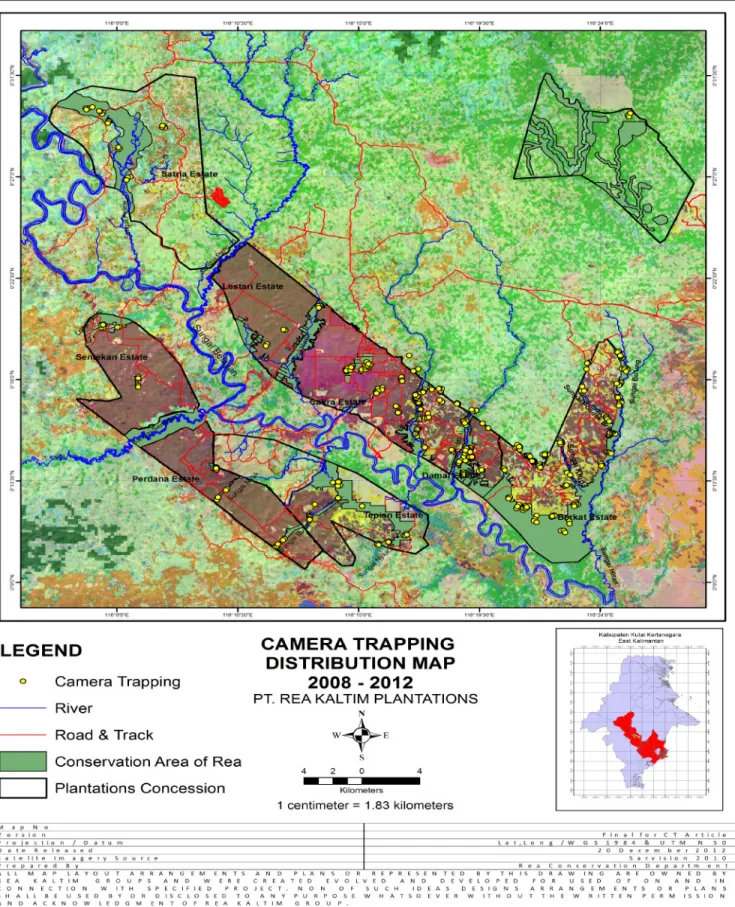
First breeding record of Banded Woodpecker Picus (Chrysophlegma) miniaceus in Indonesian Borneo
Forest birds of the peat bog of the Tuanan Research Station, Central Kalimantan, Indonesia, with notes on habitat specialists. Handbook of Birds of the World, 7/2011) Kerang birds, modified territories, mixed dipterocarp and riparian forests in Central and East Kalimantan, Indonesia. The age composition of the Microchiropteran community in the study area was dominated by adults (83.60%), followed by young (16.13%) and only 0.27 infants.
The title and full mailing address, email address, and address of the main author and any additional authors. Software: Start with a capital letter only if the name of the program is a word (e.g. Vortex, ArcGIS). Biography: This should describe the main research interests of all authors (<150 words in total), beyond what is apparent from the subject of the manuscript and the authors' affiliations.
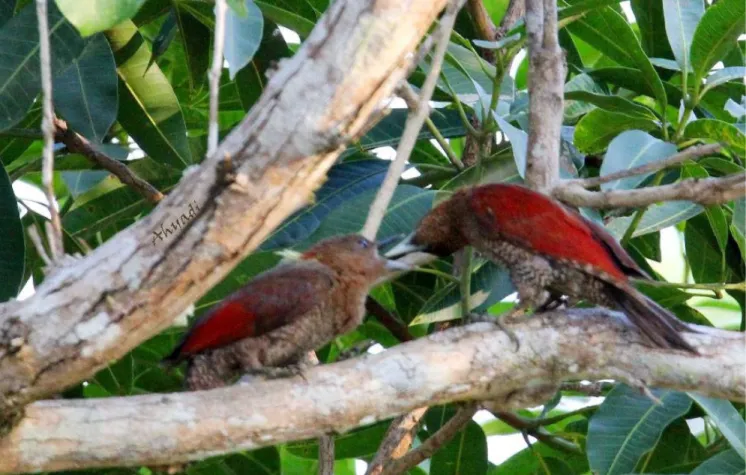
Contents
